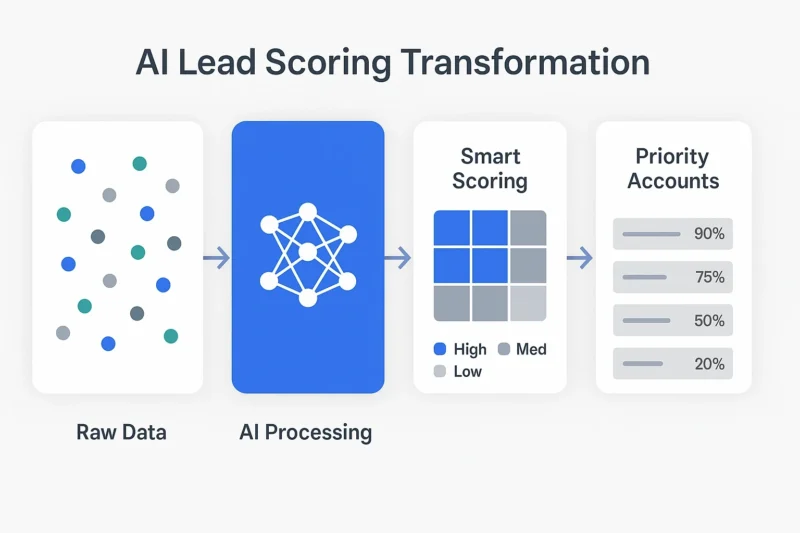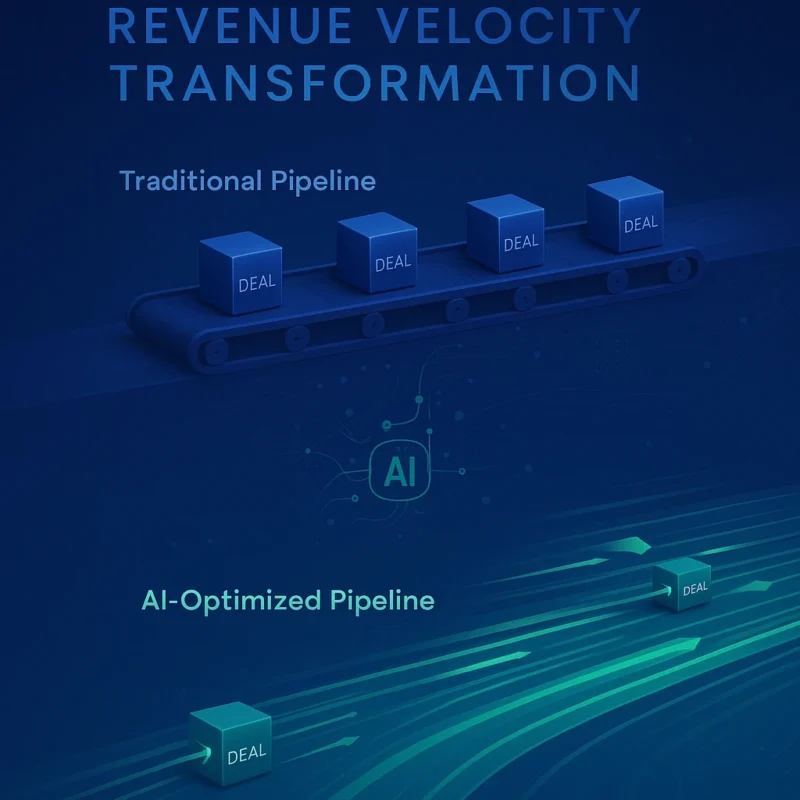How to Increase Account Pipeline Velocity with AI Analytics in 2025
Your sales pipeline moves at the speed of molasses, deals stall in predictable places, and your revenue forecasts feel more like educated guesses than data-driven predictions. Sound familiar? You’re not alone. But you don’t have to stay stuck there.
The game-changer isn’t just having more data; it’s having AI analytics that can process, prioritize, and predict with precision that human analysis simply can’t match. When B2B sales teams apply AI analytics, predictive lead scoring accuracy increases by 43%, transforming the speed at which accounts progress from first touch to closed deal.
This is about fundamentally accelerating how your pipeline operates. Companies that master this approach are seeing sales cycles shrink by double digits while their competitors struggle with the same old bottlenecks.
TABLE OF CONTENTS:
Understanding Pipeline Velocity: The Revenue Speed Formula
Pipeline velocity measures how fast your qualified prospects convert into paying customers. The formula is elegantly simple yet reveals exactly where AI can create exponential improvements:
Pipeline Velocity = (Number of Qualified Leads × Win Rate × Average Deal Size) ÷ Sales Cycle Length
Every variable in this equation responds powerfully to AI optimization. Traditional approaches might improve one factor at a time, but AI analytics creates a multiplier effect across all four variables simultaneously. This is why companies implementing AI-driven pipeline strategies aren’t seeing 10% improvements; they’re experiencing transformational velocity gains.
The most successful implementations focus on AI’s unique ability to process massive datasets in real-time, identify patterns humans miss, and predict outcomes with increasing accuracy. This creates what we call the “Velocity Flywheel”—each AI-driven improvement enhances the others, accelerating your entire revenue engine.
AI-Driven Lead Scoring: From Guesswork to Precision Targeting
Traditional lead scoring relies on demographic data and basic behavioral triggers. AI analytics transforms this process by analyzing hundreds of variables simultaneously, creating scoring models that evolve with every interaction.
The results speak volumes: predictive lead-scoring accuracy increases by 43% when B2B sales teams apply AI analytics. This isn’t just a statistical improvement; it’s the difference between your sales team spending time on accounts that will close versus spinning their wheels on prospects that were never going to buy.

Consider how Amazon Web Services approached this challenge. They used a Generative AI solution that automatically produces comprehensive account summaries by analyzing CRM data, product usage patterns, and support interactions. Since 2023, they’ve generated over 100,000 summaries, cutting 35 minutes of prep time per opportunity while creating opportunities worth 4.9% more on average.
The key is moving beyond simple demographic scoring to behavioral prediction. AI systems can identify subtle patterns, like the sequence of content downloads, the timing of website visits, or the combination of stakeholders engaging with your brand, that reliably predict purchase intent weeks before traditional methods would flag an account as sales-ready.
| Traditional Scoring | AI-Powered Scoring | Impact on Velocity |
|---|---|---|
| 20-30 basic criteria | 200+ dynamic variables | 43% accuracy improvement |
| Weekly score updates | Real-time recalculation | Instant priority shifts |
| Static demographic focus | Behavioral pattern recognition | Earlier intent detection |
| Manual review required | Automated recommendations | 35 minutes saved per opportunity |
Accelerating Deal Progression with Real-Time Intelligence
The most significant velocity gains come from AI’s ability to compress time between pipeline stages. Sales cycles shrink by 28% when AI-powered insights are used for account prioritization, and the mechanism behind this improvement is surprisingly straightforward.
AI analytics continuously monitors account behavior, engagement patterns, and external signals to identify the optimal moment for each sales action. Instead of following rigid cadences or guessing when to follow up, your team receives precise recommendations about timing, messaging, and channel selection.
One mid-market B2B SaaS provider implemented an AI analytics stack combining predictive scoring with automated nurturing. The results were dramatic: lead quality improved by 37%, the average sales cycle length decreased by 28%, and SDR response times improved by 64%. Most importantly, engagement rates tripled, creating a compounding effect that accelerated every subsequent interaction.
The breakthrough insight is that AI doesn’t just identify when accounts are ready to buy. It actively creates readiness by orchestrating perfectly timed touchpoints. This approach transforms your pipeline from a passive funnel into an intelligent system that guides prospects toward purchase decisions.
Revenue Acceleration: The Business Case for AI-Driven Velocity
Pipeline velocity improvements translate directly into revenue acceleration, but the magnitude often surprises executives. B2B companies that leverage analytics across sales and marketing are 1.5× more likely to report above-average revenue growth, according to McKinsey research.
This correlation isn’t coincidental; it reflects the compounding impact of AI on revenue generation. Faster pipeline velocity means shorter cash conversion cycles, higher annual contract values, and increased deal volume. Companies implementing comprehensive AI analytics report revenue improvements that far exceed the individual gains in velocity.
The AI transformation impact extends beyond immediate sales metrics. Organizations develop better forecasting accuracy, more efficient resource allocation, and stronger competitive positioning. These secondary benefits often prove more valuable than the initial velocity improvements.

Savvy executives recognize that pipeline velocity improvements create competitive moats. While competitors struggle with lengthy sales cycles and unpredictable forecasts, AI-optimized companies can respond more quickly to market opportunities, capture a larger market share, and command premium pricing through a superior customer experience.
Your 90-Day AI Velocity Implementation Framework
Implementing AI analytics for pipeline acceleration requires systematic execution, not random tool adoption. The most successful executions follow a structured approach that builds momentum while minimizing disruption to existing sales processes.
Phase 1: Data Foundation (Days 1-30)
Begin with comprehensive data hygiene and integration. AI analytics requires clean, consistent data to generate reliable insights. Audit your CRM data quality, standardize lead sources, and establish proper attribution tracking. This foundational work determines the success of everything that follows.
Phase 2: Predictive Scoring Implementation (Days 31-60)
Use AI-powered lead scoring using your cleaned dataset. Begin with basic behavioral scoring, then gradually incorporate more sophisticated variables, such as intent data and external signals. Train your team to interpret and act on AI-generated scores.
Phase 3: Automation and Optimization (Days 61-90)
Layer on automated workflows that respond to AI insights. This includes triggered follow-ups, dynamic content personalization, and intelligent routing. LinkedIn ABM pipelines particularly benefit from this systematic approach, enabling precise account targeting at scale.
The key to successful implementation is choosing tools that integrate seamlessly with your existing stack while providing measurable velocity improvements from day one. Solutions like Karrot.ai exemplify this approach by automating personalized LinkedIn ads and landing pages, eliminating the need for technical integration or workflow disruption.
Measuring and Maximizing Your Velocity Improvements
Successful AI implementations require continuous measurement and optimization. The metrics that matter go beyond simple conversion rates to include velocity-specific indicators that predict long-term revenue impact.
Track your pipeline velocity formula components weekly: qualified lead volume, win rates by source, average deal sizes, and cycle lengths by segment. AI analytics should improve all four variables, but the timing and magnitude vary depending on the implementation approach.
Pay particular attention to leading indicators, such as response rates, meeting-to-opportunity conversion rates, and the time between pipeline stages. These metrics often improve weeks before you see final velocity gains, providing early validation of your AI investments.
Advanced organizations implement AI-powered ABM strategies that scale personalization to thousands of accounts simultaneously. This approach combines velocity improvements with account expansion opportunities, creating multiple vectors for revenue growth.
Transform Your Pipeline Velocity: Next Steps for Immediate Impact
The evidence is clear: AI analytics can dramatically accelerate your pipeline velocity, with leading companies experiencing 28% faster sales cycles and a 43% improvement in lead scoring accuracy.
Start with a comprehensive audit of your current pipeline performance. Identify your most significant issues, measure your baseline velocity metrics, and prioritize the AI interventions that will deliver the fastest ROI. Remember, minor improvements across multiple pipeline variables create exponential velocity gains through compound effects.
The companies implementing AI velocity strategies today will dominate their markets tomorrow. The only question is whether you’ll be leading the transformation or trying to catch up to competitors who acted faster. Your pipeline velocity and your revenue growth depend on the choice you make right now.
If you’re ready to accelerate your account pipeline velocity with intelligent automation, consider starting with proven solutions that deliver immediate results. Get a Free Audit to discover precisely how AI personalization can compress your sales cycles and boost conversion rates.
Frequently Asked Questions
-
What is pipeline velocity, and why is it important?
Pipeline velocity measures the rate at which qualified leads are converted into paying customers. It’s crucial because faster pipeline velocity means shorter sales cycles, quicker revenue generation, and improved deal volume. Optimizing pipeline velocity directly accelerates revenue and improves sales team efficiency.
-
How does AI improve pipeline velocity?
AI enhances all four key variables of pipeline velocity: number of qualified leads, win rate, average deal size, and sales cycle length. AI tools analyze vast datasets in real-time, predict outcomes, and make recommendations that optimize these variables simultaneously, creating a “Velocity Flywheel” that accelerates the entire sales process.
-
What is AI-powered lead scoring, and how does it work?
AI-powered lead scoring surpasses traditional demographic-based scoring by analyzing hundreds of variables to accurately predict purchase intent. It continuously learns and adapts based on new data, enabling sales teams to focus on high-value leads and prioritize the best opportunities, increasing sales effectiveness and reducing wasted time.
-
How does AI speed up the sales cycle?
AI reduces sales cycle length by 28% by providing real-time insights and identifying the optimal time for follow-ups. AI continuously monitors account behavior and engagement patterns, recommending the best timing, messaging, and channels for each sales action. This leads to faster deal progression and higher engagement rates.
-
What are the benefits of AI-driven pipeline velocity for B2B companies?
B2B companies leveraging AI-powered pipeline velocity improvements are 1.5 times more likely to report above-average revenue growth. AI boosts revenue by accelerating sales cycles, improving deal size and win rates, and allowing companies to respond more quickly to market opportunities, thus gaining a competitive edge.
-
What is the 90-day AI implementation framework?
The 90-day framework for implementing AI-driven pipeline velocity involves three phases:
-
Phase 1 (Days 1-30): Clean and integrate data to set a solid foundation for AI analysis.
-
Phase 2 (Days 31-60): Implement predictive lead scoring using AI to evaluate prospects more accurately.
-
Phase 3 (Days 61-90): Automate workflows based on AI insights, enabling targeted follow-ups, dynamic content, and intelligent routing to improve engagement.
-
-
How do I measure the success of AI-driven pipeline velocity?
Success is measured by tracking the four components of the pipeline velocity formula: qualified leads, win rates, average deal sizes, and sales cycle lengths. Additionally, monitor key leading indicators, such as response rates, meeting-to-opportunity conversions, and the time spent between pipeline stages. These early signs can validate the effectiveness of AI interventions before final results are visible.
-
What is the next step if I want to implement AI-driven pipeline velocity in my organization?
Start by auditing your current pipeline performance, measuring your baseline metrics, and identifying areas where AI can make the most immediate impact. From there, prioritize the AI interventions that will generate the quickest return on investment, whether through improving lead scoring or automating workflows. Consider starting with proven solutions that integrate smoothly with your existing CRM systems.




